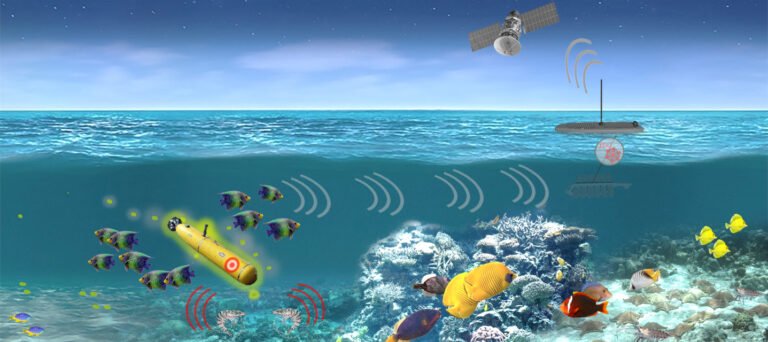Over the last three years, the U.S. Defense Advanced Research Projects Agency, DARPA, has been steadily working on a bold attempt to convert marine life into a vast army of underwater spies under the PALS program.
Instead of directly tracking adversarial subs, with the Persistent Aquatic Living Sensors (PALS) program, DARPA is turning the sensors towards marine life to harness organisms’ natural ability to sense disturbances as a means of monitoring strategic waters.
While an unconventional approach, if successful, PALS could be a stroke of genius and eco-friendly game-changer in the world of underwater reconnaissance and surveillance.
“PALS leverages the millions of years of evolution that have honed the sensory capabilities and behaviors of different organisms as well as their self-replicating, long-endurance capabilities, and to attempt to take advantage of those attributes by passively sensing their reactions and behaviors,” PALS program manager, Dr. Lori Adornato, told The Debrief in an email.


Background: Detecting Underwater Threats
For the nearly the last 80 years, acoustic monitoring and sound propagation through echo-ranging have been the primary method for tracking and detecting underwater vessels.
By measuring source level, sound spreading, sound absorption, reflection loss, ambient noise, and receiver characteristics, naval researchers during World War II developed a method of detecting submerged vessels called “Sound Navigation And Ranging.” The technique is more commonly known by its acronym: SONAR.
There are two different ways SONAR can be deployed: Active and Passive.
Active sonar detection involves creating a pulse of sound, or “ping,” under the water and then measuring the pulse’s reflections or echo. When it strikes an object, a pulses reflection, coupled with multibeam hydrophones, can provide an object’s range, speed, and bearing.
Passive sonar can provide the same information as active sonar; however, passive sonar listens without transmitting an acoustic pulse.
Because active sonar involves broadcasting an acoustic signal, thus increasing the likelihood of being detected by passive systems, active sonar is rarely used in situations where maintaining stealth is vital. Aside from military purposes, both passive and active sonar is also widely used in commercial and scientific research applications.
Another modern method for locating submerged vessels involves measuring minute variations in the earth’s magnetic field.
Because large steel-hulled submarines are primarily made from ferromagnetic materials, their presence slightly distorts the earth’s magnetic field around them. These distortions in the earth’s magnetic field can be measured by a magnetometer or magnetic anomaly detector (MAD).
Anti-submarine warfare aircraft, such as the U.S. Navy’s P-3 Orion or SH-60B Seahawk “MAD Bird,” have MAD systems they use to patrol and hunt for enemy subs. When a magnetic anomaly is detected, the maritime surveillance and reconnaissance aircraft can deploy sonobuoys, or small active sonar devices, to help locate a hidden vessel.
Recently, Forbes revealed that Raytheon’s AN/APS-154 Advanced Airborne Sensor (AAS) could make airborne non-acoustic detections of submerged vessels. An advanced solid-state ultra-fast electronically scanned array radar, the AAS, can detect wakes on the ocean’s surface caused by a submerged submarine, which are so slight, the disturbances are invisible to the human eye.
During the 1980s, the Soviet Union developed a similar system, the “System Obnarujenia Kilvaternovo Sleda,” or SOKS, that can track a submarine’s wake underwater.
Finally, space-based imaging that uses radar echoes to create high-resolution 2-or-3 dimensional representations of objects called synthetic aperture radar can be employed by satellites to detect wake disturbances and keep tabs on enemy submarines.


Analysis: DARPA’S PALS is a Different Approach To ASW
Presently, the United States enjoys virtual unquestioned acoustic supremacy by having the overall quietest, de facto, the most stealthy submarine fleet in the world. However, with its ambitious plans to become the world’s most dominant naval power, China is rapidly closing the submarine technology gap.
The recent version of China’s Shang-class Type 093G nuclear-powered submarines are believed to be nearly as quiet as the United State’s Los Angeles class ships. In 2017, China said they had developed a new shaftless rim-driven pumpjet propulsion system for their “next-generation nuclear submarines.” Security analysts have been skeptical of these claims, though if true, it could mean China already possesses stealth submarine capabilities.
In addition to submarines becoming less detectable by traditional sonar, rapid advances in unmanned underwater vehicles (UUV) are paving the way for entirely new classes of submersible vessels.
UUVs, like DARPA’s Manta Ray, will make it increasingly challenging to detect submersible vessels by non-acoustic means such as magnetic anomaly detection or synthetic aperture radar.
Ultimately, all indications point to a matter of time before current anti-submarine surveillance systems will be rendered obsolete.
To meet this future challenge, in 2018, DARPA decided to take an unconventional approach, launching the Persistent Aquatic Living Sensors (PALS) program.
Instead of monitoring enemy submarines with PALS, DARPA intends to observe marine life and convert sea organisms into a virtually limitless army of underwater spies.
The goal of PALS is to harness marine organisms’ innate abilities to detect and respond to disturbances in their environment. By watching sea life, DARPA hopes to classify and characterize responses to detect manned or unmanned underwater vehicles of all sizes, similar to how sonar uses acoustic propagation.
While DARPA’s idea might seem odd – in addition to being able to hear, taste and smell – some marine life possess unique abilities that could make them ideally suited for anti-submarine warfare.
Aquatic vertebrates have a unique system of sensory organs called the “lateral line.” The lateral line affords marine life the remarkable ability to detect movement, vibration, and changes in pressure gradients in the water surrounding them. The sensory ability provides keen spatial awareness and plays an essential role in orientation, predatory behavior, defense, and social schooling.
DARPA believes PALS could provide for a nearly limitless set of biological sensors used to monitor adversary movements across the world’s vast oceans and seas by tapping into marine life’s unique natural abilities.
“Because marine organisms are ubiquitous in their environments, self-replicating, and largely self-sustaining, sensing systems that use marine organisms as their foundation would be discreet, cost-effective, and provide persistent undersea surveillance with a minimal logistical footprint,” notes Dr. Adornato in a release issued by DARPA.


Outcome: PALS An Ecological Stroke of Genius?
PALS is hardly the first program to turn towards nature for solutions to military problems.
With the Marine Mammal Program, the U.S. Navy has teams of bottlenose dolphins and California sea lions specially trained for mine detection, clearance, and equipment recovery. During the Iraq War, the Navy’s mine-clearing dolphins were credited with detecting more than 100 anti-ship mines and underwater booby traps in waters around the southern Iraqi port of Umm Qasr.
Many recent concepts for new unmanned underwater systems have also sought to mimic marine life’s natural features. In one example, with the next-generation nuclear submarine, the Navy has said they would like to develop an underwater “mothership” that would have deployable UUVs on its exterior, similar to how Remora fish attach to sharks.
What makes PALS unique is instead of mimicking its features or directly putting ocean animals to work, PALS systems would simply monitor and record marine behavior.
The negative impact of sonar on marine mammals has been a contention point between military leadership and conservationists. Studies, including some part-funded by the U.S. Navy, have found active sonar has led to mass strandings of dolphins and blue whales and caused groups of whales to beach themselves.
In 2016, the Ninth Circuit Court ruled that the Navy had been illegally using low-frequency active sonar in more than 70% of the world’s oceans. In their ruling, the three-judge panel found that the National Marine Fisheries Service (NMFS) who approved the permit for the Navy to use low-frequency sonar had “unlawfully ignored reasonable safeguards recommended by the government’s own scientists to reduce or prevent harm from the sonar system,” resulting in a “systematic under-protection of marine mammals” throughout “most of the oceans of the world.”
In contrast, ensuring that sensors don’t create a disturbance that would influence underwater animal behavior is critical to the PALS systems’ overall effectiveness. This non-invasive form of anti-submarine warfare not only makes PALS unique but could also mean the program could be an eco-friendly game-changer for underwater surveillance and reconnaissance.
“PALS systems are not sending signals into the environment,” Dr. Adornato told The Debrief. “PALS systems are passively observing or listening to the natural world in order to issue alerts on vehicle presence.”


Dr. Adornato told The Debrief that PALS is currently not looking to replace acoustic or non-acoustic detection systems in use today. “PALS systems are intended to be complementary to current systems.”
The most crucial question for the PALS program’s success is whether marine life can detect disturbances at great enough distances that PALS could be a viable option for underwater reconnaissance and surveillance.
So far, DARPA seems to think so, and PALS has already progressed into advanced phases of development.
During Phase 1 of testing, DARPA says four different teams of researchers successfully demonstrated that marine organisms could sense an underwater vehicle’s presence and produced a unique output or observable behavior that scientists could measure. Researchers also showed they could distinguish target signals from organisms against the aquatic environment’s ambient background.
At the end of 2020, DARPA announced it had awarded contracts for teams to move on to Phase 2 to develop systems to observe, record, interpret organisms’ responses and then transmit the results to remote end-users.
According to DARPA, the four teams currently working on perfecting their PALS systems are:
- Raytheon BBN, using passive bi-static sonar to monitor snapping shrimp.
- Northrop Grumman Systems, using the snap produced by snapping shrimp as an input pulse for a 3D acoustic imaging system.
- Florida Atlantic University, using Goliath Grouper as a biological sensor.
- Naval Undersea Warfare Center-Newport Division, using an ecosystem approach to detect if a UUV has passed by a reef.
During Phase 2, researchers will have to demonstrate their sensor systems have a persistent endurance of 30 days. For those who make it to Phase 3, DARPA will double the time requirement to 60 days.
“We are currently in Phase 2 of our program,” explained Dr. Adornato. “At this point, teams are responsible for testing their concepts at further standoff ranges and developing the systems with the 30-day endurance under realistic conditions.”
Currently, DARPA expects to be completed with Phase 2, moving on to the final Phase 3 of testing by November 2021.
Follow us on Twitter, Facebook, and Instagram, to weigh in and share your thoughts. You can also get all the latest news and exciting feature content from The Debrief on Flipboard, and Pinterest. And don’t forget to subscribe to The Debrief YouTube Channel to check out The Official Debrief Podcast.

